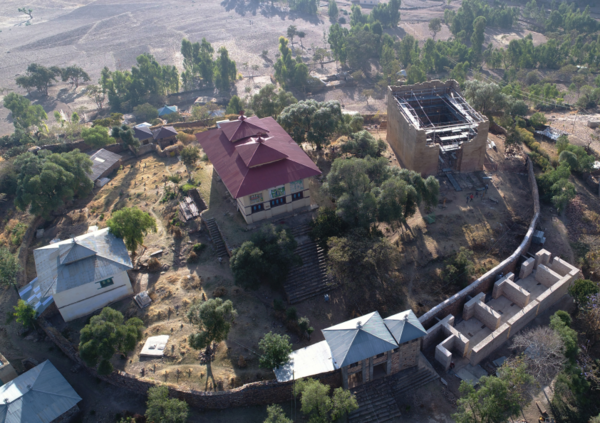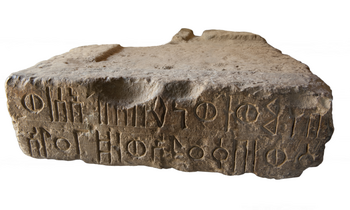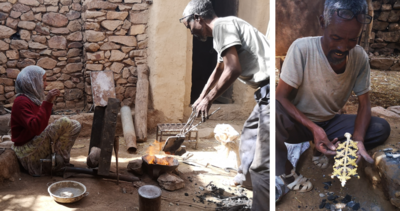CULTURAL CONTACTS BETWEEN SOUTH ARABIA AND ETHIOPIA
Reconstruction of the ancient cultural area of Yeha (Tigray/Ethiopia)
The long-term project, carried out by the Orient Department of the DAI (Archaeology) and the Research Unit Ancient South Arabia and Northeast Africa of the FSU Jena (Epigraphy), investigates the cultural contacts between the Sabaeans who migrated from South Arabia in the early 1st millennium BC and the population living in the Tigray region. The main point of research is the process of interaction of South Arabian and indigenous populations. The geographical focus is the site of Yeha, which, due to its monumental architecture and written evidence, is considered the political and religious center of this culturally and historically important but so far only rudimentarily explored region in the northern Horn of Africa. Ethnohistorical research is also included, which, due to the conservative mnemotic landscape of Tigray, allows methodologically justified conclusions to be drawn about ancient social forms and ways of life.
The epigraphic subproject carried out in Jena includes:
Studies on the Ethio-Sabaic Royal Inscriptions
Written in the Ancient South Arabian alphabet, the Ethio-Sabaic royal inscriptions show great similarities in language and form with the corresponding Early Sabaic inscriptions from South Arabia from the 1st half of the 1st millennium BCE. However, they are also characterized by significant differences to them. In a separate study, these similarities and differences will be systematically evaluated, including the question to which extent they provide insight into the political, social, and religious history of the DʿMT community. In addition, new excavation results from Yeha and the surrounding area will also be included, which will allow a more detailed chronology of this text group in the early 1st millennium BCE. (Norbert Nebes)
Studies on the Ethio-Sabaic Inscriptions
The research objective is the philological and content-related evaluation of the Ethio-Sabaic inscriptions known so far on the basis of the Ancient South Arabian text corpus. Since, in addition to a number of name graffiti, the inscriptions are mainly dedications, a special focus of the work is the evaluation of the information on the Ethio-Sabaean cult and religion. An analysis of the personal names als well as the names of clans and places will provide clues to the origin of the authors of the inscriptions and the population structure of DʿMT. A systematic presentation of the linguistic and paleographic peculiarities of the Ethio-Sabaic inscriptions will also be included. (Helen Wiegleb)
Addition of the Ethio-Sabaean corpus to the Sabaweb online dictionary
The Ethio-Sabaean corpus essentially consists of two groups of texts originating from different regions and differing in form and content. The largest group comprises around 120 graffiti inscriptions, all of which are concentrated in the region of Sänʿafe/ʿAddi Qäyyəḥ (Eritrea) and, due to the numerous personal names they contain, primarily provide onomastic information, but also include dedications and blessings. However, the more extensive part of the corpus in terms of vocabulary consists of around 75 inscriptions and fragments, most of which were applied to representative objects by stonemasons and are predominantly dedicatory inscriptions from the political centers of Yəḥa, Wuqro, and Ḥawəlti/Mälazo.
Two distinct linguistic layers can be distinguished in the Ethio-Sabaean vocabulary. The largest part consists of genuine Sabaean vocabulary, some of which has different orthography, phonology, and morphology. Individual lexemes, on the other hand, are of indigenous, Ethio-Semitic origin. In addition, there are also words that are highly likely to be of Sabaean origin but cannot yet be verified in the South Arabian lexicon. Some of these can be assumed to be new conceptual formations that are important for the Ethio-Sabaean region.
This subproject aims to compile the vocabulary of the Ethio-Sabaean inscriptions and make it available to users as an online dictionary. For this purpose, the website of the Sabaean dictionary is currently being redesigned into a comprehensive platform (Sabaweb). The presentation of the material, including context translations, older translation suggestions for the lemmas, and etymological comparative material from within and outside South Arabia, therefore follows the pattern of the Sabaean Dictionary. (Helen Wiegleb)
Ethnohistorical Studies - Tigray as a Conservative Mnemotic Landscape
The aim is to document and analyze local knowledge, oral historiographical traditions, and traditional sociopolitical practices in their linguistic and cultural context. Village material culture, which often provides explanations for archaeological finds, is also examined. In addition, oral traditions on culture and settlement history in central and eastern Tigray at ancient sites associated with Yeha are documented and analyzed for their basic patterns, some of which preserve memories of ancient ethnonyms, cultural techniques, pre-Christian religious practices, local political organizational forms, and events. (Wolbert Smidt)
project manager
research assistants
Mariam Kilargiani, M.A.
Dr. Wolbert Smidt
Helen Wiegleb, B.A.
Tobias Gerbothe
former research assistants
Dominik Oesterle, M.A.
Robert Stähle, M.A.
cooperation partners
Authority for Conservation of Cultural Heritage (ARCCH)
Tigray Culture and Tourism Bureau (TCTB)


Title image: The ancient city of Mārib | © Iris Gerlach





